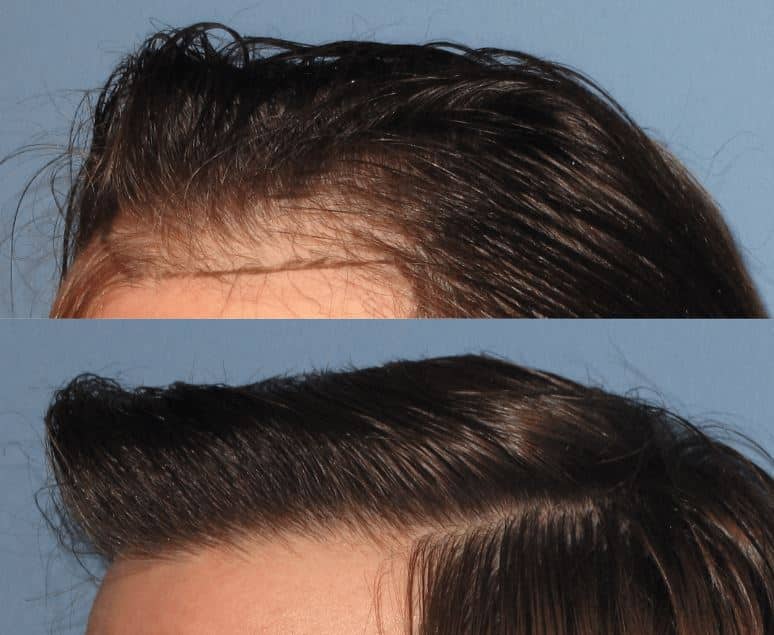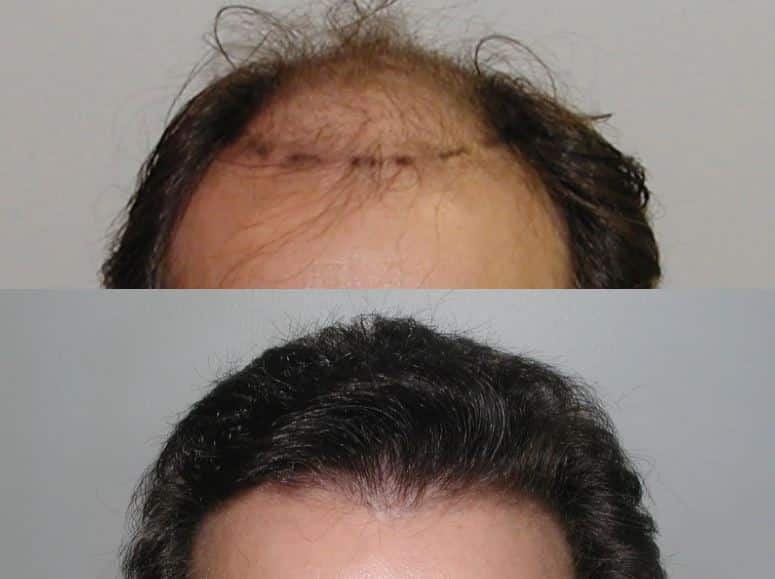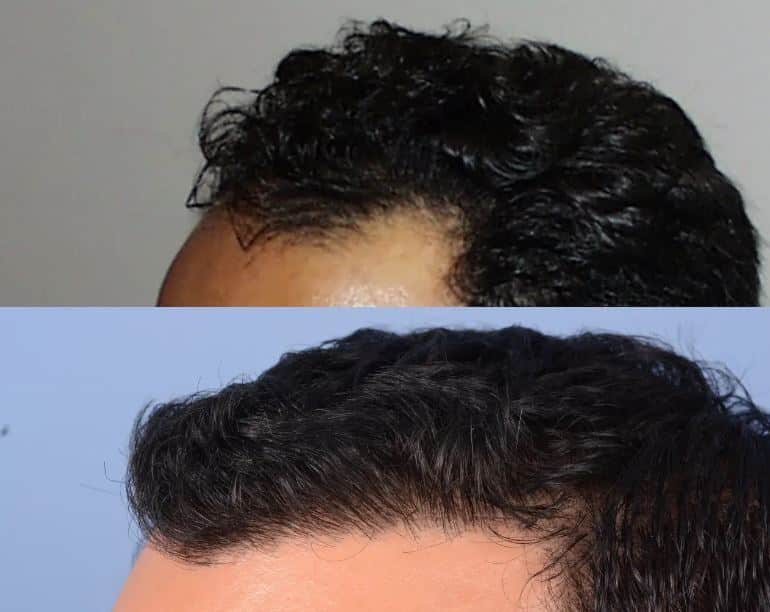How To Stop A Receding Hairline
Know what causes hairlines to recede and the treatment options available, with and without surgery.

Watching your hairline recede is not a pleasant experience. It can chip away at your confidence. It might even come in the way of your relationships. But before you resign yourself to fate (or a hat collection), there are options. At Shapiro Medical Group, we have helped thousands of men stop baldness and restore their natural hairline, with or without surgery.
Why Is My Hairline Receding?
This is the most popular question we get from our patients. Hair loss can occur for different reasons, including stress, illness, certain medications, and nutritional deficiencies. However, the most common culprit behind a receding hairline is androgenetic alopecia, also known as male pattern hair loss (MPHL).
Pattern hair loss is a genetic condition that affects roughly half of all men by the age of 50 and this is closely linked to the hormone called dihydrotestosterone (DHT). This DHT is what shrinks hair follicles over time, leading to thinner and shorter hair growth until eventually, follicles stop producing hair altogether.
While genetics play a major role in pattern baldness, it’s important to note that it’s not a guaranteed outcome. Even if you have a family history of hair loss, there are ways to manage it and potentially slow down the receding process.
Will My Hair Regrow?
Unfortunately, there’s no magic bullet to completely reverse receding hairlines. However, depending on the severity of your hair loss and how early you intervene, there are effective treatments available to slow down the process, promote some regrowth, and restore a natural hairline.
4 Receding Hairline Treatments
These are some of the most popular and well-studied treatments for restoring hairline density:
Finasteride
This FDA-approved medication works by blocking the conversion of testosterone to DHT, essentially reducing the fuel that shrinks hair follicles. Finasteride is typically taken in pill form once a day and can be highly effective in slowing down hair loss and potentially promoting some regrowth in the crown area.
It’s important to note that finasteride can have side effects, including decreased libido and erectile dysfunction. It’s crucial to discuss these potential side effects with your doctor before starting treatment.
Minoxidil
Minoxidil comes in a topical solution that you apply directly to your scalp twice daily. This is also the only FDA-approved treatment for women’s hair loss. Minoxidil is known to stimulate blood flow to the scalp and may prolong the growth phase of hair follicles.
While minoxidil can be effective in slowing down hair loss and even promoting some new hair growth, it typically takes several months of consistent use to see results. Additionally, once you stop using minoxidil, any hair regrowth you’ve experienced is likely to fall out so you have to stick to using it daily.
Platelet-Rich Plasma (PRP) Therapy
PRP therapy is a relatively new option that involves injecting your own concentrated platelets back into your scalp. These platelets contain growth factors that can stimulate hair growth. Some studies also suggest PRP injections may improve blood circulation to the hair follicles, potentially promoting a healthier hair growth environment. This can be done as a stand-alone treatment or in combination with a hair transplant procedure to help with healing.
Low-Level Laser Therapy (LLLT)
This treatment involves using low-level lasers to irradiate the scalp. The proposed benefits include improved blood circulation to the scalp and stimulation of hair follicles. You can get this treatment at your provider’s office or at the comfort of your own home with portable LLLT devices.
Hair Transplant as a Permanent Option to a Receding Hairline
Currently, a hair transplant is the only permanent solution to restoring your hairline. It involves transplanting healthy hair follicles from a donor area on the scalp, typically the back or sides of the head, to the balding area. When done by an experienced surgeon, the results can look remarkably natural, which our surgeons at Shapiro Medical Group have consistently done over the years.
There are two main techniques used in hair transplants:
Follicular Unit Extraction (FUE)
This minimally invasive procedure involves extracting individual follicular units, which typically contain 1-4 hairs, directly from the donor area using a small punch device. The extracted follicles are then meticulously prepared and transplanted into tiny recipient sites created in the balding area.
FUE offers several advantages, including:
- Minimal scarring: FUE leaves behind only tiny puncture marks at the donor site, which are usually well-concealed by surrounding hair.
- Shorter recovery time: Most patients experience minimal discomfort after FUE and can return to work and most activities within a few days.
- More flexible donor area: FUE allows for harvesting follicles from a broader area of the scalp, which can be beneficial if you have significant hair loss or plan for future procedures.
However, FUE also has some limitations:
- Cost: FUE is typically more expensive than FUT due to the time and expertise required for individual follicle extraction.
- Longer procedure time: Extracting individual follicles can be a more time-consuming process compared to FUT strip harvesting.
- Graft survival rate: While generally high, the survival rate of transplanted follicles can be slightly lower with FUE compared to FUT.
Follicular Unit Transplantation (FUT)
In this technique, a thin strip of scalp is removed from the donor area. This strip is then meticulously dissected under specialized microscopes to isolate individual follicular units. These units are then transplanted into the recipient sites on the balding scalp.
FUT offers a few advantages:
- Cost: FUT is generally less expensive than FUE. Dissecting this strip under microscopes allows for efficient extraction of a large number of follicles in a shorter time, which translates to less overall procedure time for the surgeon and potentially lower overall cost.
- Graft survival rate: FUT may have a slightly higher rate of graft survival compared to FUE.
However, FUT also has some drawbacks including:
- Linear scar: FUT leaves a linear scar at the donor site, which can be a concern for some men, especially those who prefer short hairstyles.
- Longer recovery time: Recovery from FUT typically takes longer than FUE due to the removal of a strip of scalp from the donor area.
- Limited donor area: FUT relies on harvesting a strip from a specific donor area, which might not be ideal for extensive hair loss or future procedures.
Read more: Is A Hair Transplant Permanent?
So, when is a hair transplant right for you, and which technique (FUE or FUT) is best?
It’s hard to say if you need a hair transplant without consulting a qualified surgeon. They can assess your hair situation, including the severity of your hair loss, scalp laxity (looseness), your desired outcome, and discuss the pros and cons of both FUE and FUT. Generally, we recommend our patients to consider the following:
- Scarring concerns: If you have a strong preference for minimal scarring and plan to keep your hair short, FUE might be a better option.
- Cost: If budget is a major concern, FUT might be a more cost-effective choice. However, keep in mind that the cost difference might be outweighed by the benefits of a quicker recovery and minimal scarring with FUE.
- The extent of hair loss: For extensive hair loss, FUE’s ability to harvest follicles from a broader donor area can be advantageous.
- Your preferences: Ultimately, the best technique depends on your individual needs and priorities. Discuss both FUE and FUT with your surgeon and choose the option that best aligns with your goals and comfort level.
Trust Our Results.
You have options at Shapiro Medical. But whether or not they will work for you depends on your unique situation. Our surgeons will work with you one-on-one and walk you through the hair restoration process from beginning to end.
If you’re eager to restore your hairline and confidence, call us to schedule a consultation today. We serve patients in and around Minneapolis, including Golden Valley, Columbia Heights, Roseville, Richfield, and the greater Minnesota area.
Hairline Restoration Before & After Photos
Head to our gallery to see more hair restoration results like these.




